A bullet’s accuracy and lethal reach hinge on its shape and speed – also its materials and internal design.
The primitive explosive “Chinese snow” predated by a couple of centuries a useful description of gunpowder by English friar Roger Bacon. Not for another six decades would anyone of record burn it in a tube to hurl a projectile with the pressure of the resulting gas. In 1327 Edward II carried crude firearms as weapons during his invasion of Scotland. Bullets as we know them were far in the future.
In the 14th century, shooters fretted more about ignition than about accuracy. Gunpowder, then a 50/25/25 mix of saltpeter, charcoal and sulfur, wasn’t well captured or protected from weather in a gun’s lock. Ignition from a smoldering wick (matchlock) was so iffy that early barrels were fitted with ax-heads, a short-range but reliable alternative in battle.
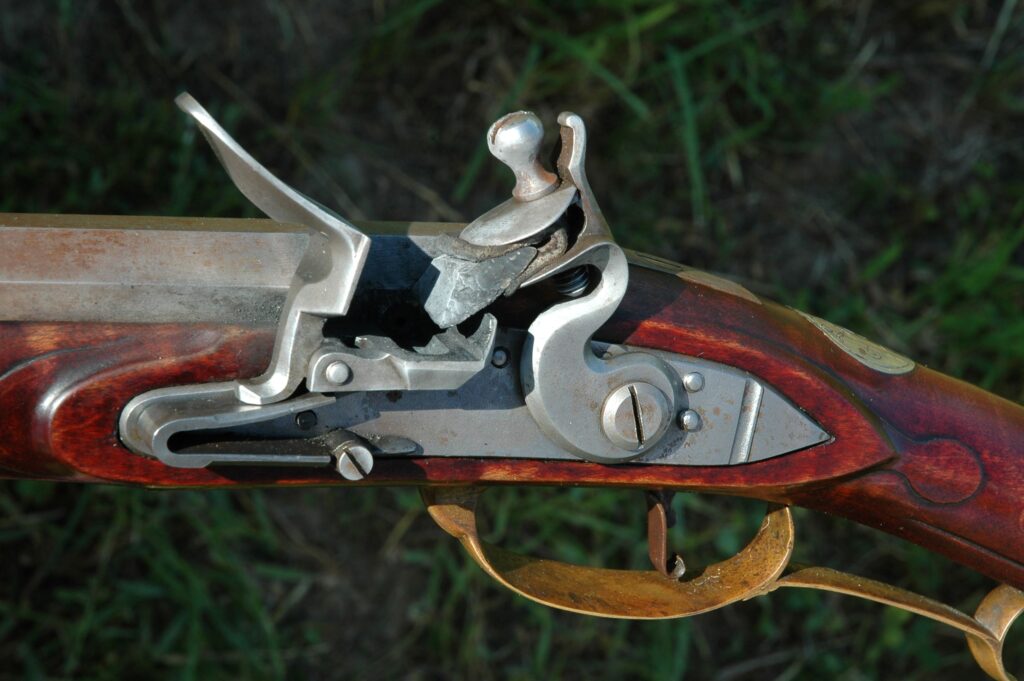
A greased patch about a bore-size lead ball eased loading into the muzzle of a flintlock rifle. The patch “took” the rifling grooves and spun the ball.
If early musketeers contemplated sending stones from gun barrels, they soon thought better of it. A stone couldn’t be made to fit the bore, so was wildly inaccurate. Without wadding, powder gas blew by, wasting energy. A steady diet of stones would soon have ruined any barrel.
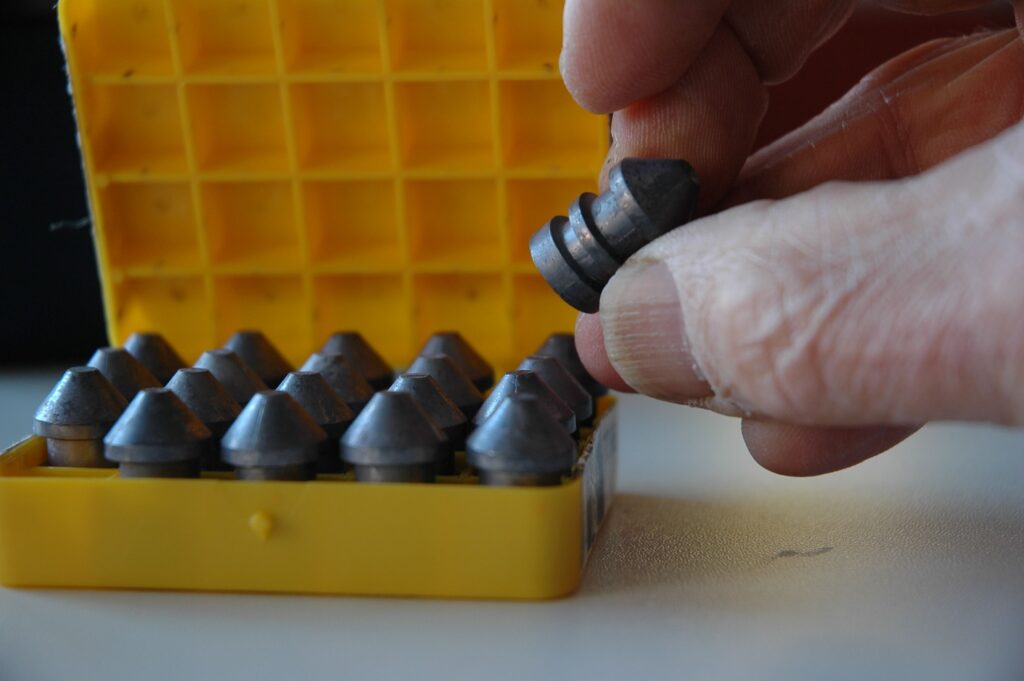
Modern muzzle-loader bullets include full-diameter “naked” lead MaxiBalls, with grease grooves
Enter lead, a soft metal with a low melting point. It can be easily cast and shaped to fit a bore, so can use the thrust of powder gas efficiently. Lead’s other advantage is its specific gravity (SG), relative to that of the common standard of water. A cubic centimeter of water at 4 degrees C weighs 1 gram. SG is 1. The SG of igneous rock is about 3. Lead’s SG exceeds 11 and is matched by few elements. Uranium and gold come in at around 19. While gold can be easily formed into balls, they’d be pricy.
Shooters wielding muzzle-loading muskets were quite satisfied with lead balls, which are easy to cast. There’s no need to orient them in loading. With minimal bearing surface, they slide obligingly down onto powder charges. When rifling arrived in the 16th century, groove-diameter balls had to be engraved by the rifling’s lands during loading. A tough job. Enter the greased patch. Cradling a bore-diameter ball, the patch slipped obediently into rifling grooves and cleaned them on its trip down the bore. Upon firing, it helped seal powder gas, while it “took” the rifling and spun the ball before dropping away in flight.

The .44-40, in 1873 Winchester’s first centerfire cartridge, was chambered in both rifles and revolvers. As black-powder velocities were low in both, lead bullets worked fine. No jackets needed.
Still, balls of any material are inefficient missiles. Big or little, they strain against the atmosphere. At any speed, a heavy lead ball has more momentum than a lightweight ball, but meets more air resistance due to its bigger face. Both soon shed their zip and accuracy in flight. Conical bullets replaced them in the 19th century. Claude-Etienne Minie, a captain in the French army, improved on a bullet by Henri Delvigne to develop, in 1847, a bullet with a hollow base and an iron heel cap. Firing drove the cap forward into the cavity, bulging the bullet’s skirt into the rifling. James Burton at the U.S. Harper’s Ferry Armory refined Minie’s bullet in 1855, discarding the base cap. His bullet impressed elite troops like Col. Hiram Berdan’s Sharpshooters. To join this elite group in 1861, aspirants had to put 10 consecutive shots into a 200-yard target, average measure from center not to exceed 5 inches! From Union and Confederate rifles, Burton’s bullet caused most of the casualties in our Civil War.
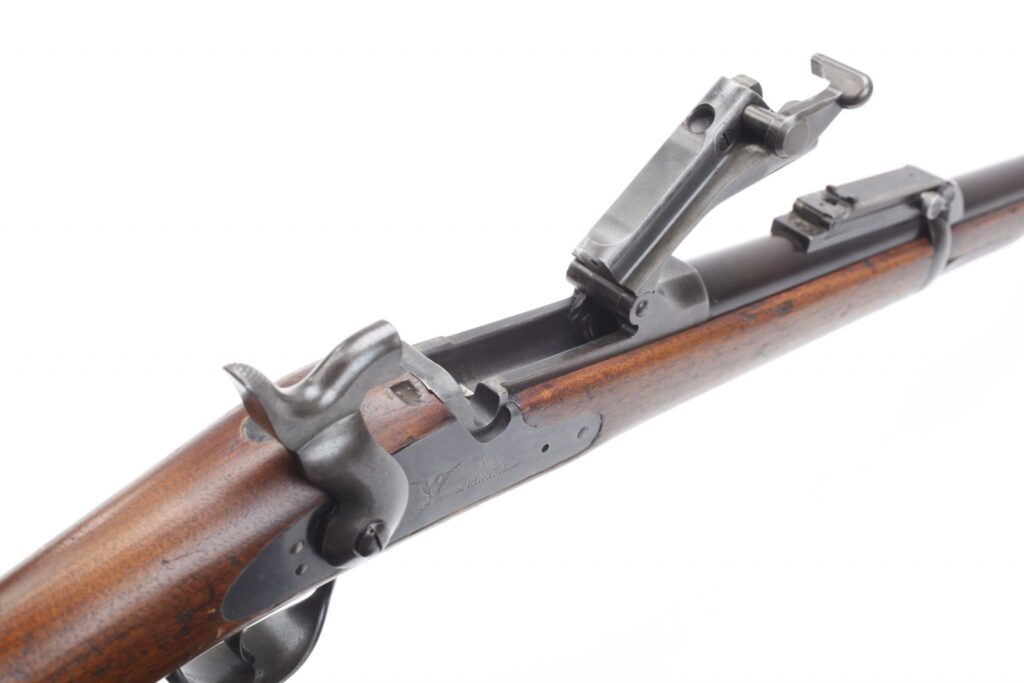
The 1873 “trapdoor” Springfield fired lead bullets from black-powder .45-70 loads at about 1,300 fps.
During the 1870s single-shot breech-loading rifles by Remington and Sharps swept the prairies of buffalo. It was a period of many excesses in our nation’s march toward “manifest destiny.” Market hunter George Reighard told of killing 79 buffalo with 91 bullets from a single stand, moving only to dodge the lingering smoke while “switching out” two scoped Sharps .50s to keep their barrels cool.
In the 1890s smokeless powder launched bullets at speeds higher than they could handle without smearing bores with molten lead. In traditional cartridges, harder lead alloy and shallow, fast-twist rifling gave good accuracy without excessive fouling. Then munitions companies turned to the copper-jacketed bullet developed in 1882 by Lt. Col. Eduard Rubin of the Swiss Army and used successfully in the 8mm Lebel, the world’s first smokeless cartridge. Stateside at Western Cartridge Co., trials with various metals yielded Lubaloy jackets of 90 percent copper, 8 percent zinc and 2 percent tin. This early “gilding metal” evolved into the 95/5 copper/zinc alloy standard in modern bullet jackets.

Smokeless loads in stout rifles give the .45-70 real muscle with hard-cast (here) and jacketed bullets
High-velocity cartridges like the .270 and .300 H&H, both introduced by Western in 1925, called for thicker jackets to brook increasingly violent impact on game. Peters’ Inner-Belted and its successor, the Remington Core-Lokt, were among early designs to resist fragmentation. Winchester’s Precision Point had a cone of jacket material covering the bullet tip and anchored at three points under the jacket proper. Three lead “windows” at the juncture of cone and jacket initiated upset. Peters followed with its Protected Point. A cone point capped a lead core whose front third was wrapped in a driving band under the jacket. During upset, the nose pushed the band rearward, where it braked expansion. A Protected Point bullet required three hours and 51 operations to make! Winchester’s answer: a similar bullet without the band. It became the Silvertip.
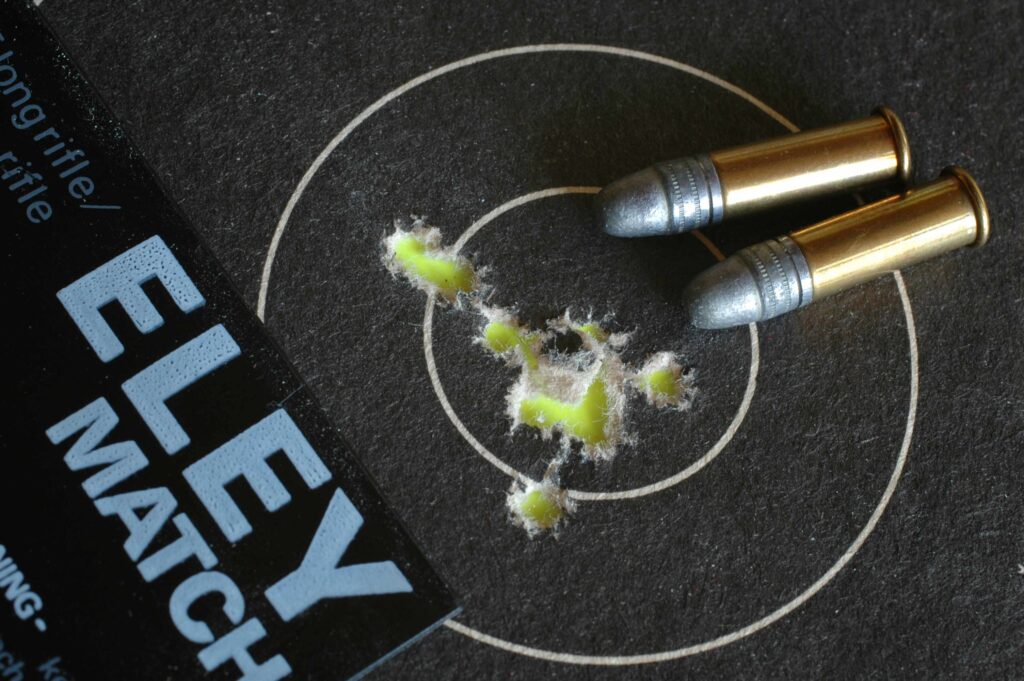
Outside-lubricated sub-sonic .22 match bullets can yield fine accuracy (this prone group at 100 yards).
Remington’s Bronze Point looks as if it could pierce concrete. But this aerodynamic bullet, no longer listed, could deliver bomb-like upset at high impact speeds. It is essentially a hollowpoint, its cavity holding a pointed peg forced into the core at impact. Nosler’s Ballistic Tip and now several polymer-tipped bullets are of similar design. Many are renowned for accuracy. Behavior in game depends a great deal on cavity design and jacket thickness up front. While hollowpoint bullets without tips were once assumed to open violently or fragment in deer-size game, Western Tool and Copper Works made a small-cavity hollowpoint that worked well on elk-size animals, even when driven by powerful cartridges like the .30 Newton. Europe’s DWM sold a “strong-jacket” bullet with a long, narrow nose cavity lined with copper tubing. Berger, known for the fine accuracy of its target bullets, now makes hollowpoint hunting bullets with very high ballistic coefficients.

Bullets for the old .25-20 (here next to a .30-30 round) have thin jackets with lots of lead exposed, to ensure upset in thin-skinned game upon low-speed impact. Muzzle velocity of this load: just 1,450 fps.
On a hunt shortly after WW II, Oregonian John Nosler shot a mud-encrusted moose repeatedly with his .300 H&H before the animal fell. His bullets hadn’t driven deep enough. So John designed his Partition bullet, a dam of jacket material behind the ogive halting upset and enabling the bullet’s heel to penetrate like a solid. Early Partition jackets were machined from tube stock, leaving a frosted exterior finish with a shiny belt. They had a wee hole in the dividing wall, and seldom was it centered. When the company began making jackets by impact extrusion, smooth, bright exteriors resulted. The hole went away; accuracy improved. The earlier RWS H-Mantle bullet is of similar design. Lee Reed improved on the concept with his Swift A-Frame, bonding the nose section to its jacket.
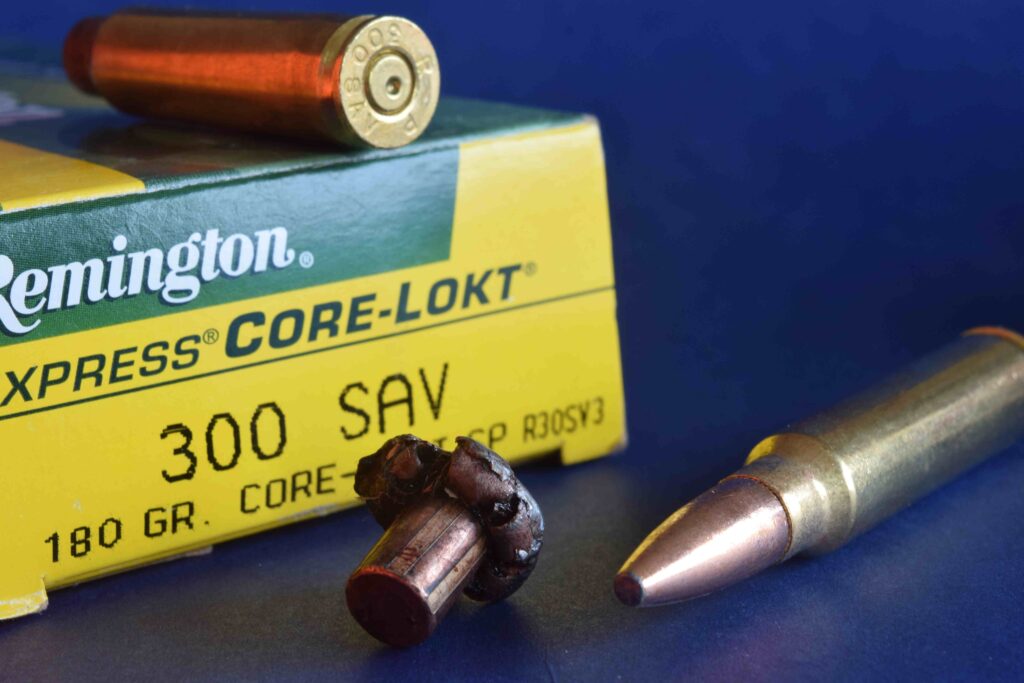
The .300 Savage appeared in 1920, marking a trend to stronger jackets and less lead exposure at the nose, to control upset upon high-speed impact.
RWS has long marketed TIG (Torpedo Ideal) and TUG (Torpedo Universal) bullets. The shank of a TIG has a funnel-shaped mouth to accept the coned butt of the front section. Upset begins at this juncture as well as at the nose. The rear core opens slowest because it’s hardest. A TUG’s rear section fits into a cavity in the front section. On impact, the nose gets slammed from both ends and opens violently. The shank powers on. Speer also gave its Grand Slam bullet a two-part core, the rear section harder than the front.

All-copper hollowpoints drive deep with little lead loss, but perform best in smaller “velocity windows” than lead-core bullets. Here: Hornady GMXs retrieved from an elk shot at 200 yards (right) and 15 yards.
Trophy-Bonded bullets, as developed by Jack Carter in the 1980s, wore jackets of pure copper rod, progressively annealed to be harder at the base than at the nose. Jackets were very thick at the base. Some changes have followed. TB bullets, the latest with a polymer tip, are now made and loaded by Federal.

No long-range champ, a Woodleigh solid plows deep in tough game. Note the thickness of this buffalo hide and the cup-shaped bullet tip to help keep the missile on a true course.
In 1985Randy Brooks designed a solid-copper bullets. The hollowpoint Barnes X-Bullet resulted. Its scored nose gave four-petal upset in the shape of an X. The subsequent TSX, or Triple-Shock featured driving bands that improved accuracy. Solid-copper hollowpoints have since appeared from all quarters, delivering deep penetration and high weight retention in game. Of course, a copper bullet must be longer to match the weight of a same-shape, same-diameter lead bullet. Polymer tips also add length.
Tipped bullets have been around since before WW II, but not until recently did polymer become a practical alternative to metal in bullet tips. The tip has less to do with a bullet’s flight than many shooters think. Still, engineers hail the uniformity of polymer tips, pointing out that hollowpoint noses are hard to finish perfectly. The tip and its fit in the nose cavity, with the cavity’s dimensions, also affect bullet upset. Poly tips now appear on bonded bullets, like Nosler’s AccuBond and Swift’s Scirocco.
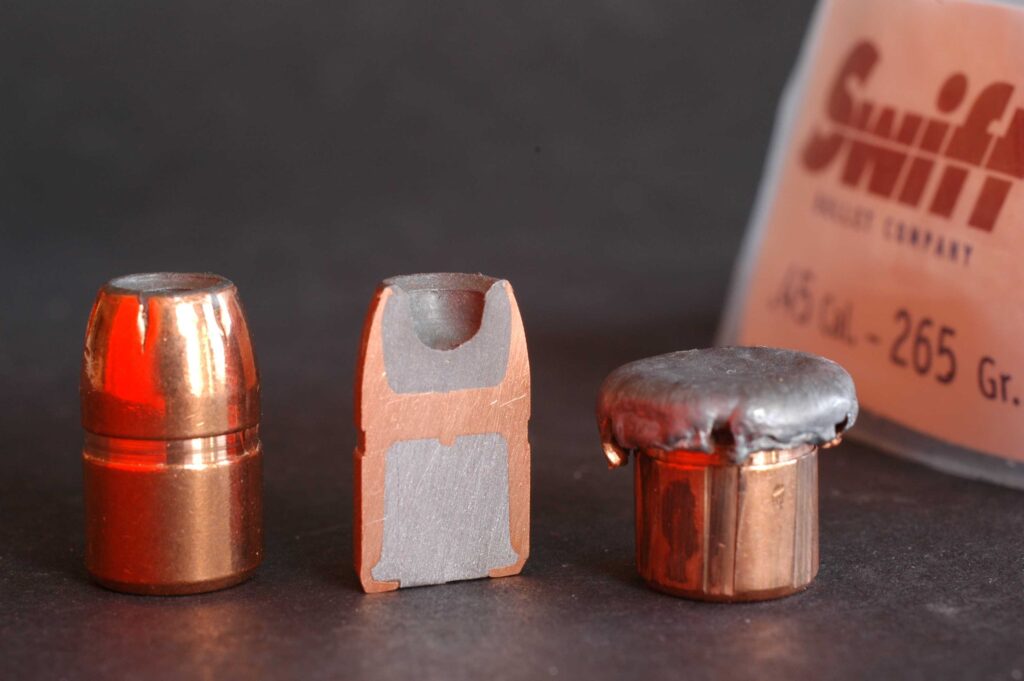
The divided-core design of this Swift A-Frame pistol bullet appeared earlier on RWS H-Mantle and Nosler Partition rifle bullets. It limits expansion to the front half, ensures penetration by the heel.
In 2005 Hornady tapped a soft, resilient polymer to make pointed bullets safe in tube magazines of lever rifles, where primers are jammed by spring pressure and recoil against bullet noses behind them. Hornady FTX bullets in LeverEvolution ammunition fly much flatter and retain speed and energy better downrange than their flat-nose predecessors.

Resilient polymer tips on Hornady’s FTX bullets make LeverEvolution loads safe in tube magazines. These bullets fly flatter and more accurately, retain velocity and energy better than flat-nose bullets.
Harder polymers got attention when Doppler radar in Hornady trials showed tip distortion during long flights from bullets sent very fast. Dave Emary, then Hornady’s chief engineer, and his colleague Joe Theilen told me: “Changes in ballistic coefficient during flight suggested their polymer tips were melting. Friction induced by sustained speeds near Mach 3 can bump tip temperatures over 800 F. A melting tip loses its shape and increases drag.” Result: steeper arcs, diminished accuracy. The Hornady Heat Shield Tip inspired by those trials has a glass transition temperature (at which polymer turns rubbery) of 475 F – eight times higher than for most poly tips! A Heat Shield Tip won’t melt until its temperature hits 700 F.
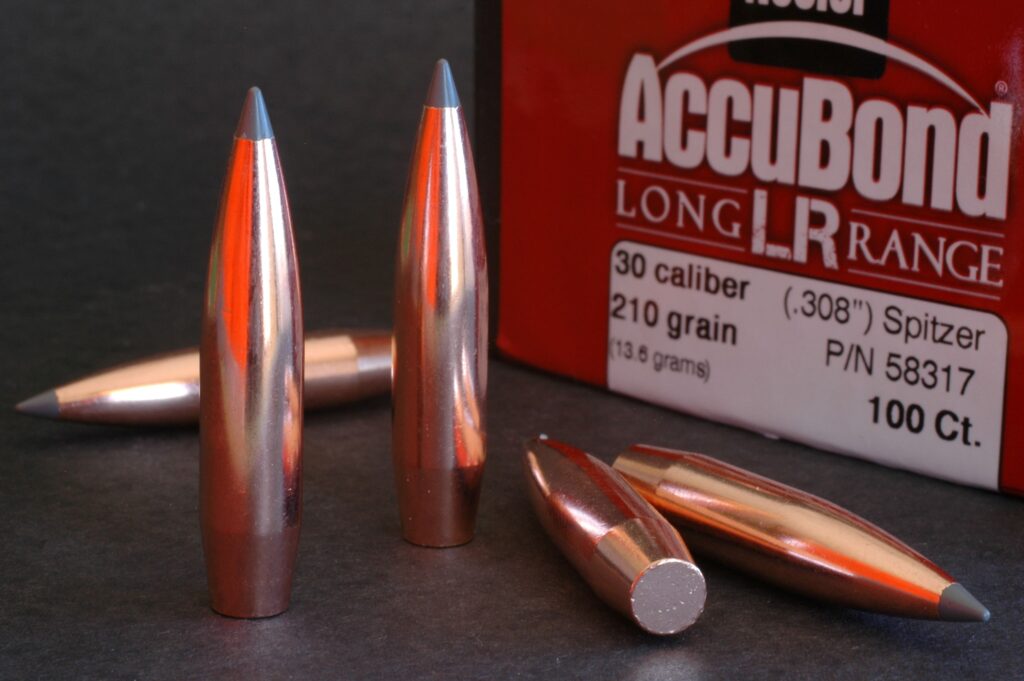
Long noses, tapered heels, polymer tips help these game bullets excel at distance. They’re bonded too, so core and jacket cling to each other during upset in tough game, after high-speed impact.
“While tip temperatures of very fast bullets can exceed that mark,” Emary said, “no bullet reaches it quickly, or stays that hot for long. Our Doppler hasn’t shown tip melt for any polymer inside 300 yards. The HST simply ensures against deformation on extended flights at high speeds.”
Hornady’s pioneering work with Doppler radar produced its ELD-X and ELD-Match bullets. The growing popularity of long-range shooting has inspired other manufacturers to offer similar bullets.
Whatever your picks in component bullets and factory loads, for hunting or target shooting, you’ll do well to shop at Midsouth Shooters Supply. Beyond having what you want, Midsouth staff knows about it! There’s no charge for advice.







